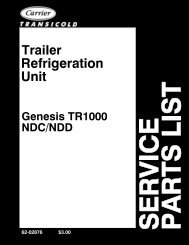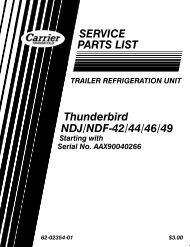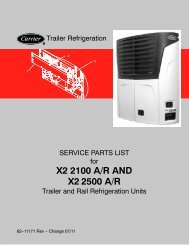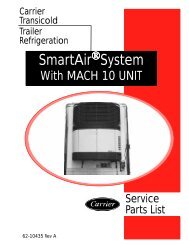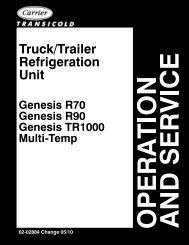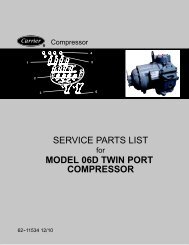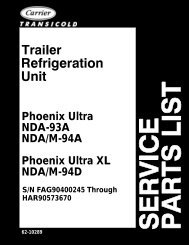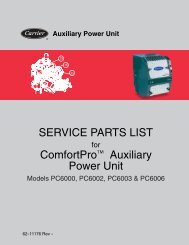x series with advance micro - Sunbelt Transport Refrigeration
x series with advance micro - Sunbelt Transport Refrigeration
x series with advance micro - Sunbelt Transport Refrigeration
- No tags were found...
You also want an ePaper? Increase the reach of your titles
YUMPU automatically turns print PDFs into web optimized ePapers that Google loves.
2.3.8 Compressor Transducers and Sensorsa. Compressor Suction Pressure Transducer (CSP)Provides <strong>micro</strong>processor <strong>with</strong> suction pressureinformation to be displayed, recorded in theDataRecorder and used to control the refrigerationsystem. It cannot be calibrated. It is located near the oilpump on the compressor.b. Compressor Discharge Pressure Transducer(CDP)Provides <strong>micro</strong>processor <strong>with</strong> discharge pressureinformation to be displayed, recorded in theDataRecorder and used to control the refrigerationsystem. It can be calibrated. It is located on the centercylinder head of the compressor.c. Compressor Discharge Temperature SensorTransducer (CDT)Provides <strong>micro</strong>processor <strong>with</strong> compressor dischargetemperature information to be displayed, recorded inthe DataRecorder and used to control the refrigerationsystem. It is located on the center cylinder head of thecompressor.It will shut the unit down if center compressor headdischarge temperature reaches 310°F (154°C) for threeminutes or 350°F (177°C). If ambient temperaturesensor (AAT) is at 120°F(49°C) or higher, the CDT limitsare increased to 340°F (171°C) for three minutes.d. Compressor Suction Modulation Valve (CSMV)The CSMV opens and closes as required for capacitycontrol of the refrigeration system cooling cycle. It islocated in the suction line at the exit of the evaporatorpod.e. Ambient Air Temperature Sensor (AAT)AAT is a temperature control probe which provides the<strong>micro</strong>processor <strong>with</strong> ambient air temperature informationto be displayed, recorded in the DataRecorder andused to control the refrigeration system. It is locatedbehind the condenser grille.2.4 EVAPORATOR SECTIONThe evaporator fits into a rectangular opening in theupper portion of the front wall of the refrigeratedcompartment front wall. When installed, the evaporatorsection is located inside this compartment, and thecondensing section is outside.The evaporator assembly consists of an evaporator coil,an evaporator fan motor, a thermal expansion valve, aheat exchanger, a defrost termination sensor (DTT),supply (SAT) and return (RAT) air sensors (SeeFigure 2-7.2.4.1 Thermal Expansion ValveThe thermal expansion valve is an automatic devicewhich controls the flow of liquid to the evaporator accordingto changes in superheat to the refrigerant leavingthe evaporator. The thermal expansion valve maintainsa relatively constant degree of superheat in the gasleaving the evaporator regardless of suction pressure.Thus, the valve has a dual function; automatic expansioncontrol and prevention of liquid return to the compressor.2.4.2 Heat ExchangerThe heat exchanger is the tube in tube type and is connectedin the main suction line and liquid line. The coldsuction gas is used to cool the warm liquid refrigerant<strong>with</strong>in the heat exchanger. This results in greater systemcapacity and efficiency.2.4.3 Evaporator CoilThe unit evaporator is a tube and fin type. The operationof the compressor maintains a reduced pressure <strong>with</strong>inthe coil. At this reduced pressure, the liquid refrigerantevaporates at a temperature sufficiently low enough toabsorb heat from the air.Heating is accomplished by circulating hot gas directlyfrom the compressor to the evaporator coil. Solenoidvalves control the refrigerant circuit to operate theheating/cooling system.Automatic evaporator coil defrosting is initiated by eithersensing the air pressure drop across the coil <strong>with</strong> adifferential air switch or <strong>with</strong> the defrost timer in the<strong>micro</strong>processor.As perishable products respire, they consume oxygen(O 2 ) and give off carbon dioxide (CO 2 ). This willeventually cause the atmosphere <strong>with</strong>in a refrigeratedcompartment to have higher levels of CO 2 and lowerlevels of O 2. This may adversely affect the shelf life ofsome sensitive perishable products. When transportingthese products, it may be desirable to maintain normalatmospheric conditions (prevent the build up of CO 2 andthe depletion of O 2 ) by using fresh air exchange, inaddition to accurate temperature control. AutoFresh AirExchange provides the ability to control the amount offresh air <strong>with</strong>out the need for manual intervention whilein transit. AutoFresh Air Exchange can also be used tolower the humidity level <strong>with</strong>in a refrigeratedcompartment IF the ambient air has a lower humiditylevel.AutoFresh Air Exchange is a factory-installed option, asit requires a modified evaporator pod. (See Figure 2-7)When AutoFresh Air Exchange is operational and “ON”,two air ports open. The upper port allows fresh ambientair to enter while stale air exits through the lower port.AutoFresh Air Exchange is available for all setpoints ator above +28°F (-2.2°C). AutoFresh Air Exchange is notoperational when the setpoint is set below +28°F(-2.2°C) or when the unit is in Defrost, or when the unithas cycled off in Auto Start-Stop. (Refer to Section3.20.4 for more information on AutoFresh AirExchange.)62-106832--14



